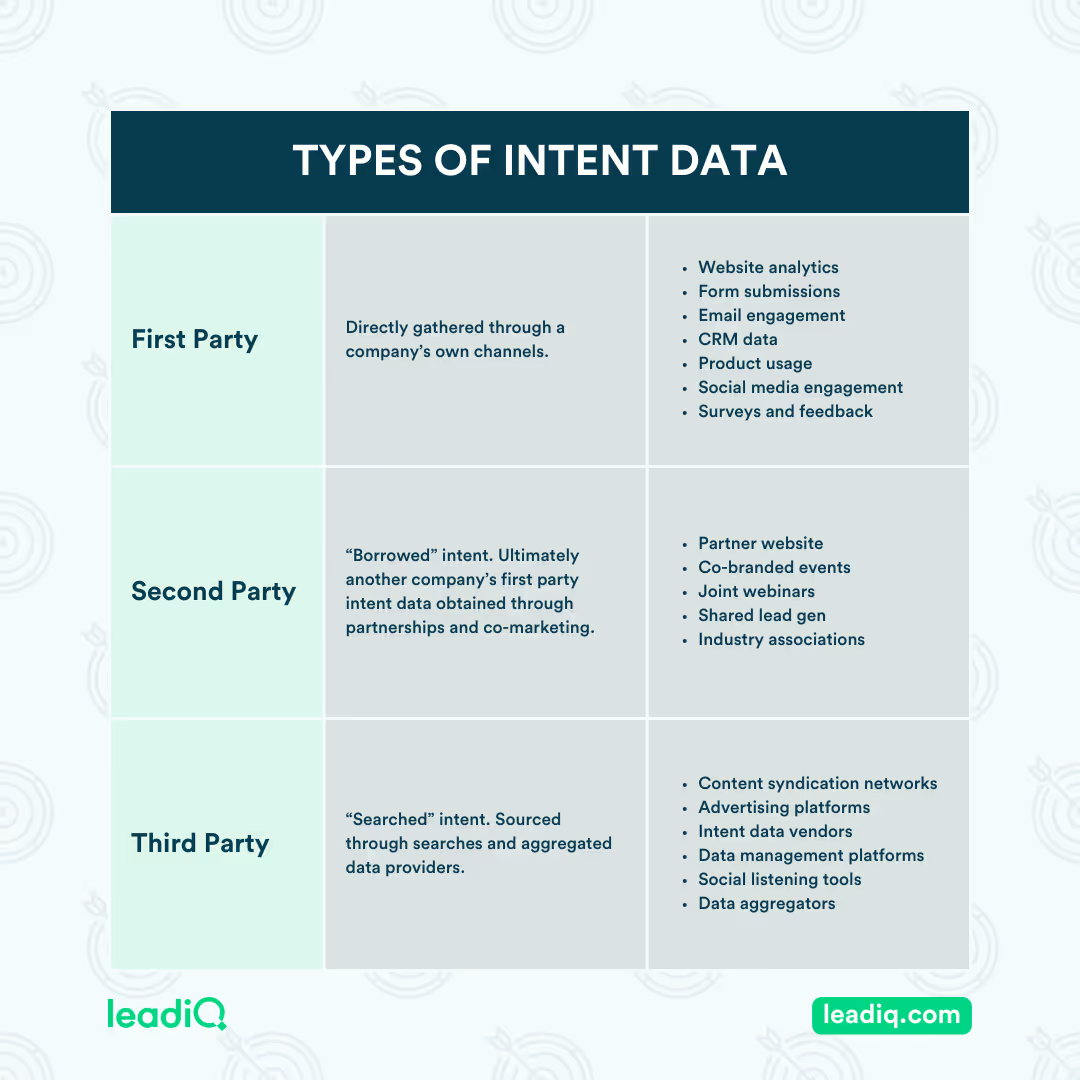Ready to create more pipeline?
Get a demo and discover why thousands of SDR and Sales teams trust LeadIQ to help them build pipeline confidently.



B2B intent data, including search, engagement, technographic, and firmographic data, provides insights into where prospects are in the buying journey, enabling more personalized and effective outreach.

For intent data to be actionable, strong alignment between sales and marketing is crucial, allowing for shared insights, optimized strategies, and targeted outbound sequences.

Leveraging intent data shifts the focus from cold to warm outreach, where sales teams engage with prospects who have already shown interest, leading to higher conversion rates.
Get a demo and discover why thousands of SDR and Sales teams trust LeadIQ to help them build pipeline confidently.
In modern B2B sales, intent data and buying signals have become invaluable tools for understanding customer behavior and identifying sales opportunities.
In case you’re unfamiliar, B2B intent data refers to the digital footprints individuals and companies leave behind as they research products and services online. These signals indicate a potential interest or need, providing valuable insights into where prospects are in the buying journey.
Having and tracking intent data is not enough. Putting your intent data into action that drives pipeline requires strong alignment between sales and marketing teams. By working together, these teams can leverage data analytics and predictive modeling to identify relevant signals and prioritize outreach efforts accordingly. Sales teams can then create targeted outbound sequences tailored to the specific needs and interests of prospects who are demonstrably interested in their organization’s products and services, increasing the likelihood of conversion.
At LeadIQ, we’re firm believers in this maxim: Cold outreach is dead. Long live warm outreach!
In today’s increasingly competitive landscape, warm outreach strategies — focusing on building relationships and delivering value to prospects through personalized, relevant communication — is taking on more prominence.
Keep reading to learn more about what B2B intent data is, how to interpret buying signals, and the easiest way to incorporate both into your outbound sequences.
B2B intent data encompasses behavioral signals and online activities that indicate a potential interest or need for a product or service within a business context. Examples of intent data include website visits, content downloads, keyword searches, social media interactions, and participation in industry forums or events.
For example, a marketing manager researching email marketing software solutions and downloading whitepapers on email automation may indicate that the individual is interested in investing in an email marketing platform.
While related to intent data, buying signals are actions prospects take that directly indicate their interest in making a purchase. These signals are more direct in nature — think requesting a demo, submitting a form on a pricing page, or attending a webinar on a specific product or solution. As such, buying signals provide deeper insights into a prospect’s stage in the buying journey and their level of engagement, making it easier to identify high-value leads.
Intent data is collected through various channels, including first-, second-, and third-party sources.
By leveraging a combination of these data sources, businesses can gain valuable insights into customer intent, preferences, and purchasing behavior — and adjust their sales strategies accordingly.

When sales teams are equipped with sales engagement platforms that integrate with first-, second-, and third-party intent providers, they’re able to aggregate and analyze data in one spot, which streamlines their workflows and makes it easier to surface insights and recommendations about which accounts to target first.
For example, LeadIQ integrates with Gong Engage. As a result, you can incorporate contact data and job change signals from LeadIQ directly into Gong Engage and combine that with other sources of intent data, making it easier for reps to see the big picture.
Learn more about LeadIQ’s integration with Gong and our partnership.

There are four main types of B2B buyer intent data:
There are two different kinds of B2B buying signals: explicit signals (i.e., hand-raise intent) and implicit signals (i.e., passive intent).
Explicit buying signals are clear, direct indicators that a prospect is interested in potentially purchasing products and services. These include direct inquiries, requests for demos or proposals, signing up for a trial of a SaaS product, or downloading high-value relevant content (e.g., a gated whitepaper).
Implicit buying signals are more subtle, requiring interpretation. These include web behavior, content engagement, and interactions on social media. While implicit signals could indicate a prospect is interested in doing business with you, they could also mean the individual simply sees something they like or is curious about a certain topic.
By aligning on shared goals, leveraging data-driven insights, and fostering open communication, marketing and sales can work together to capture and correctly interpret intent data.
Marketing plays a critical role in capturing intent through various channels — like social media, website interactions, email engagement, and content consumption metrics. Sales teams, on the other hand, provide valuable insights from direct customer interactions and feedback.
By sharing data and observations, both teams can gain a holistic understanding of customer intent and behavior. Regular meetings and feedback sessions can help teams facilitate discussions about emerging trends, refining target audience profiles, and optimizing messaging strategies.
Additionally, implementing a robust tech stack that enables seamless data integration and tracking can make it easier for teams to identify and prioritize high-intent leads for personalized outreach and conversion.
Creating alignment between sales and marketing is paramount to ensure the success of leveraging your intent — and at large starts most companies on their journey to account-based marketing.
It’s no secret today’s B2B landscape is hypercompetitive. By incorporating B2B buyer intent data and buying signals into their outbound efforts, sales teams can gain an edge, targeting leads more effectively to drive better results.
Here’s how to do that:
In today’s busy business climate, sales teams can cut through the noise by leveraging intent data and buying signals and using them to engage prospects with relevant messaging at the most opportune times.
Ready to see how LeadIQ can help you move beyond cold outreach and find warm pipeline faster and more efficiently? Take our prospecting platform for a test drive today or schedule a demo with our prospecting experts.